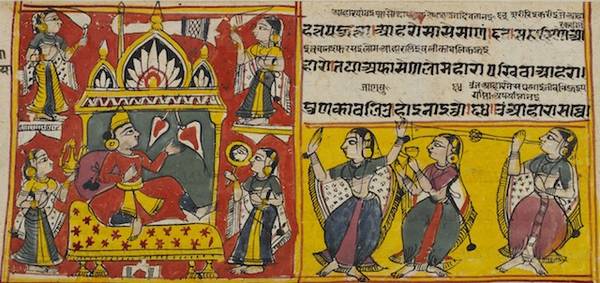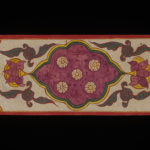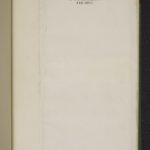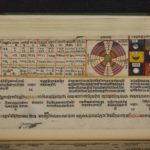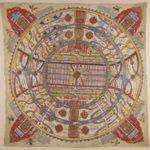Article: Writings on the universe
The religious importance of understanding the traditional conception of the universe means that scholars and devotees have made strong efforts to pass on Jain cosmology. This is usually in written texts on cosmology but visual art has also been an important way to spread knowledge.
There are three main areas of Jain literature that are sources for details of cosmology. The scriptural source is the most significant, followed by popular stories and then numerous references in a variety of works.
On the whole, the diverse Jain religious groups agree on cosmology. Both main sects support the religious authority of the Tattvārtha-sūtra, which is a key Jain text with a long section on cosmology. This underscores the crucial part of cosmological theory in the basic tenets of Jain belief. There are some differences, however, between the beliefs of Śvetāmbara and Digambara Jains, which can be spotted in the textual traditions of each group.
Tattvārtha-sūtra
One of the most concise, comprehensive and earliest accounts of Jain cosmology is the Tattvārtha-sūtra. Written in Sanskrit in the first centuries of the Common Era and the only text considered an authoritative scripture by Śvetāmbaras and Digambaras alike, the Tattvārtha-sūtra summarises the main principles of Jain belief.
After describing the nature of the soul in chapter two, the Tattvārtha-sūtra gives the various places where it can take rebirth in chapters three and four.
Chapter three
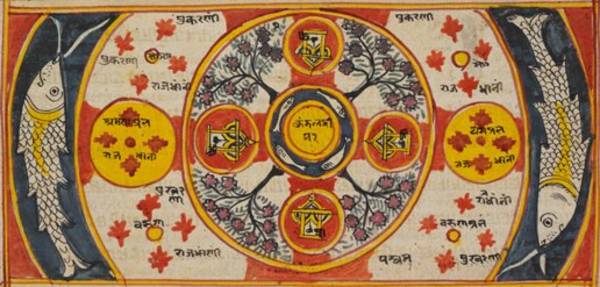
Continent of Kuṇḍala
Image by British Library © CC0 1.0 (Creative Commons Public Domain)
The third chapter of the Tattvārtha-sūtra goes into great detail about the lower and middle worlds of the Jain universe.
These areas are two of the regions of world space where souls move through the cycle of birth over many lifetimes. The souls are born into different bodies and lives throughout various parts of the Jain triple worlds according to the karma their behaviour has created in previous births.
The following table summarises the headings in chapter three.
|
The lower region: the seven infernal lands |
The middle region |
|---|---|
|
Dimensions and topography |
Concentric islands and oceans |
|
Strata and dwelling places for the infernal beings |
Jambū Island’s geography |
|
Physical make-up of the infernal beings |
The seven continents of Jambū:
|
|
Sufferings of the infernal beings |
Dhātakīkhaṇḍa Island |
|
Lifespans of the infernal beings |
Puṣkara Island |
|
|
Islands of human habitation |
|
|
The two classes of humans |
|
|
Continents where spiritual effort is possible |
|
|
Lifespans of humans |
|
|
Lifespans of animals and lower organisms |
Chapter four
The fourth chapter provides an immense amount of detail about the upper world of the Jain universe. The upper world is where many deities reside, although gods and goddesses are also found in other parts of the three worlds. The lives of the gods are characterised by pleasure and lack of effort, unlike the lives of human beings in the Lands of Action. The gods are in a higher spiritual condition than human beings but are not liberated souls. Only human beings can reach omniscience and liberation so it is better to be born as a human being in the middle world than a god in the upper world.
The following table summarises the headings in chapter four of the Tattvārtha-sūtra.
|
Colouring of the gods |
|
Types of gods within each class |
|
Chiefs and other grades of gods |
|
Sexual pleasures of the gods |
|
1. The ten types of mansion-dwelling gods |
|
2. The eight types of forest gods |
|
3. The five types of luminous gods
|
|
4. The empyrean gods
|
|
Subhumans (animals, plants, micro-organisms) |
|
Lifespans of the gods
|
|
Lifespans of infernal beings
|
Other writings
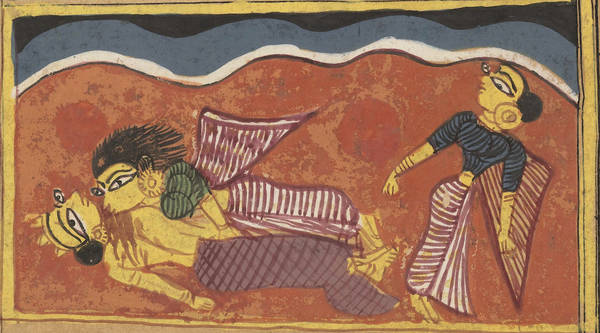
Amṛtamati kills Yaśodhara and Candramatī
Image by Wellcome Trust Library © Wellcome Library, London
Although the primary textual sources on Jain cosmology are the scriptures, story literature contains plentiful examples of how these cosmological concepts work in practice.
As well as shorter writings, there are instances of fairly long texts, similar to novels, with narratives embedded in one another, in which cosmology plays an important role. These tales are like theatres where human beings play one life after the other, travelling back and forth among the middle, lower and upper worlds in continuous rebirths until they are spiritually mature enough to reach liberation. A good example is a popular tale known as the story of Yaśodhara, which offers rich scope for illustrations of the workings of karma. One manuscript of the story is one of the highlights of JAINpedia.
Finally, there is the evident familiarity of Jain authors, mainly mendicants, with the details of cosmology. There are frequent precise references or looser allusions in literary works, for example in comparisons.
Śvetāmbara tradition
Three principal types of Śvetāmbara writings describe Jain cosmology. The first type is scriptural, with several scriptures going into immense detail about Jain cosmological concepts, with associated commentaries in various languages.
A huge body of literature in Prakrit focuses on cosmological matters. This can be classified into those texts known as kṣetra-samāsas – ‘condensed exposition of the regions’ – and those known as saṃgrahaṇīs – ‘résumés’. The most influential of other Prakrit-language works on cosmology is the 16th‑century Vicāraṣaṭṭriṃśikā, and also its Sanskrit commentary.
The final type of Śvetāmbara writing to deal with cosmology is Vinaya-vijaya’s Loka-prakāśa. Composed in Sanskrit verse in the 17th century, it is a kind of compendium of cosmology, which quotes extensively from earlier works and was widely copied.
Canonical scriptures
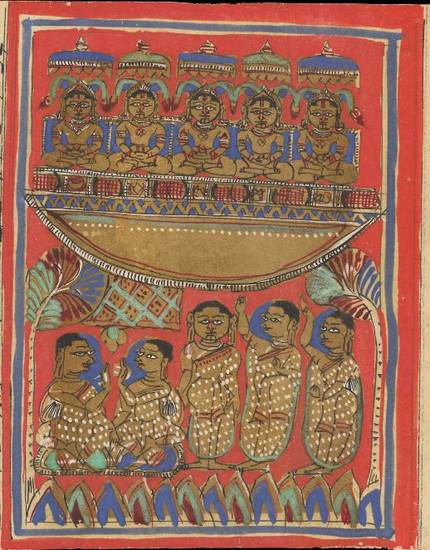
Perfect beings and paths to liberation
Image by British Library © CC0 1.0 (Creative Commons Public Domain)
Written in Ardhamāgadhī Prakrit, the Vyākhyāprajñapti – Exposition of Explanations – is the fifth Aṅga of the Śvetāmbara canonical scriptures. It is a massive book containing virtually everything related to the teachings of Jain doctrine so, although it is not a specialised treatise on cosmology, it holds a lot of cosmological material. Information is also available in other Aṅgas such as the Sthānānga and the Samavāyānga – Aṅgas number three and four.
The Jīvājīvābhigama – Approach to the Animate and Inanimate – belongs to the category known as Upāṅgas. These form the second category of Śvetāmbara canonical scriptures, in which there are 12 texts written in Ardhamāgadhī Prakrit. The Jīvājīvābhigama is the third text, in prose. Its third chapter contains a description of continents and oceans but is considered by some to be a later insertion.
The Jambū-dvīpa-prajñapti – Exposition of the Jambū-dvīpa – is the fifth or sixth of the Upāṅgas. Devoted to Jain cosmology, it is in seven prose sections. The Jambū-dvīpa-prajñapti is an exhaustive description of the ‘Rose-apple continent‘ in an elaborate canonical style. It details all the components of Jambū-dvīpa – encircling wall, mountains, shrines, gardens, ponds, astral bodies, rivers, the surrounding Lavaṇa-samudra. It emphasises its repetitive structure, with microcosmos and macrocosmos replicas of each other. The atmosphere is opulent – gems, gold and silver are the usual materials described – and the depiction often recalls those of royal palaces and gardens or those of holy places and pilgrimage sites. The third section is an account of the region of Bhārata and deals with the legends connected with King Bharata.
The Sūrya-prajñapti – Exposition of the Sun – and the Candra-prajñapti – Exposition of the Moon – are also Upāṅgas. The Sūrya-prajñapti is the sixth and the Candra-prajñapti the seventh. They are works of astronomy, dealing with activities and effects of the sun and the moon (Schubring 2000: 100–103 for details).
All these treatises have been the starting point of a long tradition of commentaries in Sanskrit and in vernacular languages, especially Gujarati.
|
Title |
Sanskrit commentary |
|---|---|
|
Jīvājīvābhigama |
|
|
Jambū-dvīpa-prajñapti |
|
|
Sūrya-prajñapti and Candra-prajñapti |
|
Prakrit treatises
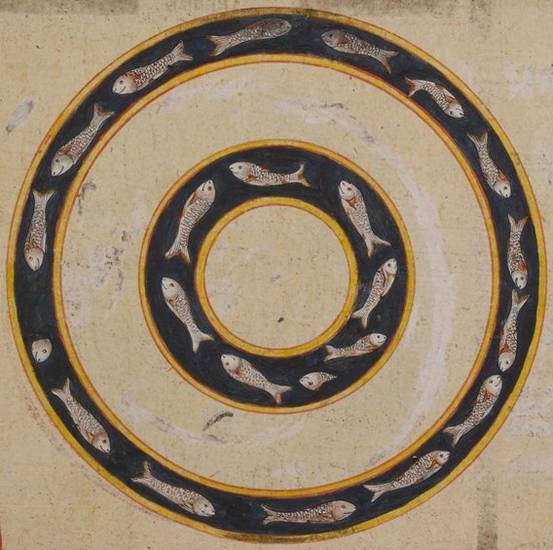
Lavaṇa-samudra and Kālodadhi oceans
Image by British Library © CC0 1.0 (Creative Commons Public Domain)
There is a vast number of specific works in Prakrit on cosmological teachings. These derive from the teachings in the canonical scriptures but can be considered a modernisation for two leading reasons.
Firstly, the language used is now Māhārāṣṭrī Jain Prakrit instead of Ardhamāgadhī Prakrit. Secondly, the form is no longer that of emphatic canonical prose but that of verses. These are often very concise, meant to be memorised. They have given birth to a long tradition of commentaries in Sanskrit and vernacular languages, especially Gujarati. Many such commentaries were written in the 17th century, proving a renewed interest in the topic of cosmology at that point.
Although there is some overlap, there are essentially two categories of Prakrit works:
- kṣetra-samāsas – ‘condensed expositions of the regions’
- saṃgrahaṇīs – ‘résumés’.
To some extent, kṣetra-samāsas are more technical and more geographical, dealing with the description of the continents, the planets and so on. The latter are more concerned with the beings who live in different parts of the Jain worlds, especially their lifespans, karma and spiritual progress.
Among other specialised treatises, at least one has to be mentioned because it is part of the fundamentals of the monastic curriculum. It has been copied many times, demonstrating its popularity. Called the Vicāraṣaṭṭriṃśikā or Cauvīsadaṇḍa, Daṇḍakaprakaraṇa and Laghu-saṃgrahaṇī, it was produced by Gajasāra. He also wrote a Sanskrit commentary in 1522 (Vikrama Saṃvat 1579). In 44 stanzas, it discusses the various limits of cosmological concepts, such as the body size of the classes of gods, their type of knowledge and their physical structure.
Kṣetra-samāsas
There are three kṣetra-samāsas that have been most influential.
The earliest is the Kṣetra-samāsa by Jinabhadra, which is also known as Samayakhitta-samāsa or Bṛhat-kṣetra-samāsa. Written in the sixth century, it gained commentaries by Haribhadra in the eighth century and Malaya-giri in the 12th century.
It was replaced in eminence by Somatilaka-sūri’s Kṣetra-samāsa, composed around 1300 CE.
Finally, there is Ratnaśekhara-sūri’s Kṣetra-samāsa or Laghu-kṣetra-samāsa, produced around 1370 CE. The most popular kṣetra-samāsa, it has been copied many times and plenty of illustrated manuscripts survive.
Saṃgrahanīs

Palaces of hellish gods and demi-gods
Image by British Library © CC0 1.0 (Creative Commons Public Domain)
The most authoritative saṃgrahanīs number three.
The first is the Saṃgrahaṇī or Bṛhat-saṃgrahaṇī by Jinabhadra, authored in the sixth century.
Next is the Jambū-dvīpa-saṃgrahaṇī, composed in Prakrit by Haribhadra in the eighth century (van den Bossche 2007). Sometimes called Laghu-saṃgrahaṇī, it consists of 30 stanzas giving definitions and calculations relating to the description of the ‘Rose-apple continent‘. Prabhāṇanda wrote a Sanskrit commentary in the 13th century.
Śrīcandra-sūri’s Saṃgrahaṇī-ratna was written in 1136 CE (Vikrama Samvat 1193). It is also known as Saṃkṣipta-saṃgrahaṇī or Trailokyadīpikā or by the name Bṛhat-saṃgrahaṇī, which is given to it by some modern Jain editors. One of the most popular treatises, it comprises roughly 273 stanzas, according to the edition, and has commentaries by Devabhadra-sūri and other leading scholar-monks.
Sanskrit manual – the Loka-prakāśa
Written in Sanskrit verse in the 17th century, the Loka-prakāśa by Vinaya-vijaya is a comprehensive cosmological treatise. It has numerous quotations from earlier works on Jain cosmology, which are also discussed in detail, and its popularity is shown by the relatively large number of illustrated manuscripts in existence.
Unfortunately, none is available among the manuscripts currently on JAINpedia. However, as well as a multitude of copies in India, Mette 2010 (392ff.) lists:
- one in the National Library and the University of Strasbourg in France
- one in the National Library of Florence in Italy
- one in the Bavarian National Library, in Munich in Germany.
Digambara tradition
The Śvetāmbara and Digambara sects agree broadly on Jain cosmology but have developed distinct traditions in cosmological writings. The most notable Digambara works are the Tiloyapannatti and the Trilokasāra in Prakrit verse and the Sanskrit-language Trailokyadīpikā. The last is the standard handbook for the Digambara tradition on Jain cosmology but does not seem to have been published.
Tiloyapannatti
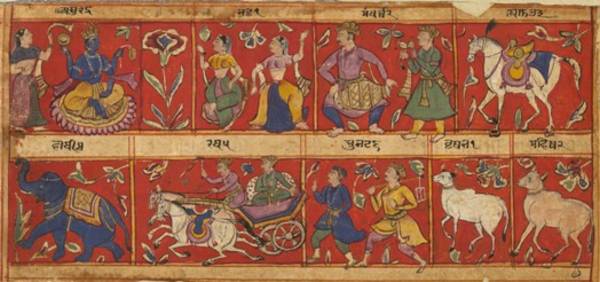
Armies of the Bhavanavāsin gods
Image by Victoria and Albert Museum © V&A Images/Victoria and Albert Museum, London
The earliest available Digambara text on cosmology is the Tiloyapannatti. In Śaurasenī Prakrit, it is a verse treatise written by Yativṛṣabha. It is difficult to date, with some scholars placing it in the second century CE while others date it to the sixth century CE. This comprehensive work is a mathematical treatise as much as a cosmological work, full of calculations, rules and definitions.
It is divided into nine chapters, named:
- General nature of the universe
- Hellish regions
- Regions inhabited by the Bhavana-vāsins
- Human world
- Sub-human world
- Regions inhabited by the Vyantaras
- Regions inhabited by the Jyotiṣkas
- Heavenly regions
- The realm of liberation.
Reading
- Commentary on Tattvārtha Sūtra of Vācaka Umāsvāti
Pandit Sukhlalji - translated by K. K. Dixit
L. D. series; volume 44
L. D. Institute of Indology; Ahmedabad, Gujarat, India; 1974
- Steps to Liberation: 2500 Years of Jain Art and Religion
Jan van Alphen - Etnografisch Museum Antwerpen; Antwerp, Belgium; 2000
- ‘Une peinture cosmologique jaina déposée au Musée Guimet: texte et traduction’
Nalini Balbir - Bulletin d’Études Indiennes
volume 24–25
Association Française pour les Études Indiennes; Paris, France; 2006 to 2007
- ‘Le monde médian: une peinture cosmologique jaina sur tissu déposée au Musée Guimet’
Nalini Balbir - Arts Asiatiques
volume 64
École Française d’Extrême-Orient; Paris, France; 2009
- Elements of Jaina Geography: The Jambūdvīpasaṃgrahaṇī of Haribhadra Sūri
Haribhadra - translated and edited by Frank van den Bossche
Motilal Banarsidass; New Delhi, India; 2007
- Jain Cosmology
Colette Caillat and Ravi Kumar - translated by R. Norman
Bookwise (India) Pct. Ltd; New Delhi, India; 2004
- Essays on Jaina Art
Anand K. Coomaraswamy - edited by Richard J. Cohen
Indira Gandhi National Centre for the Arts and Manohar; New Delhi, India; 2003
- Victorious Ones: Jain Images of Perfection
Phyllis Granoff - Mapin Publishing Pvt. Ltd and Rubin Museum of Art, New York; Ahmedabad, Gujarat, India and New York, USA; 2009
- ‘Meru, Samavasaraṇa and Siṃhāsana: The Recurrence of Three-Tiered Structures in Jaina Cosmology, Mythology and Ritual’
Julia A. B. Hegewald - Kalhar (White Water-Lily): Studies in Art, Iconography and Archaeology of India and Bangladesh – Professor Enamul Haque Felicitation Volume
edited by Gerd R. Mevissen, Gourishwar Bhattacharya, Mallar Mitra and Sutapa Sinha
Kaveri Books; New Delhi, India; 2007
- ‘Oceans, Islands and Sacred Mountains: Representations of Cosmic Geography in Jaina Art and Architecture’
Julia A. B. Hegewald - Cosmos: the Journal of the Traditional Cosmological Society
volume 16
Traditional Cosmological Society; 2000
- Jaina Temple Architecture in India: The Development of a Distinct Language in Space and Ritual
Julia A. B. Hegewald - Monographien zur Indischen Archäologie, Kunst und Philologie series; volume 19
Stiftung Ernst Waldschmidt, G+H Verlag; Berlin, Germany; 2009
- ‘Lokākāśa and Lokadhātu: A Comparison of Jain and Buddhist Cosmology’
Padmanabh S. Jaini - The Clever Adulteress and Other Stories: A Treasury of Jain Literature
edited by Phyllis Granoff
Mosaic Press; Oakville, Ontario, Canada; New York, USA; London, UK; 1990
- Die Kosmographie der Inder: nach den Quellen dargestellt
Willibald Kirfel - Georg Olms; Hildesheim, Lower Saxony, Germany; 1967
- The Scientific Foundations of Jainism
K. V. Mardia - edited by Dayanand Bhargava
Lala Sunder Lal Jain Research series; volume 5
Motilal Banarsidass; New Delhi, India; 1996
- Die Erlösungslehre der Jaina: Legenden, Parabeln, Erzählungen
- translated and edited by Adelheid Mette
Insel Verlag; Berlin, Germany; 2010
- The Doctrine of the Jainas: Described after the Old Sources
Walther Schubring - translated by Wolfgang Bühlen
edited by Satya Ranjan Banerjee
Lala Sunder Lal Jain Research series; volume 15
Motilal Banarsidass; New Delhi, India; 2000
- That Which Is: Tattvārtha Sūtra
Umāsvāti / Umāsvāmi - translated by Nathmal Tatia
Sacred Literature series
International Sacred Literature Trust in association with Harper Collins; London, UK; 1994
- Treasures of Jaina Bhandāras
Umakant Premanand Shah - L. D. series; volume 69
L. D. Institute of Indology; Ahmedabad, Gujarat, India; 1978
- Tiloyapannatti: Teaching on the Three Worlds
Yativṛṣabha - translated by Pandit Balchandra Shastri
edited by A. N. Upadhye and Hiralal Jain
Jaina Saṃskṛti Saṃrakshaka Sangha series
Jīvarāja Jaina Granthamālā; Solapur, Maharashtra, India; 2008
Links
- Jain universe
-
The Herenow4U website provides a detailed diagram of the Jain universe and a summary of traditional cosmology. It is a page from the 2008 edition of Introduction to Jainism by Rudi Jansma and Sneh Rani Jain.
- Digambar Jain Trilok Shodh Sansthan
-
Opened in 1985, the Digambar Jain Trilok Shodh Sansthan – Digambar Jain Institute of Cosmographic Research – in Hastinapur, Uttar Pradesh, was founded by Āryikā Jñānamati. A centre of research into Jain cosmology, the institute publishes the Vira Jñānodaya Granthamālā series and the Samyagjñāna journal and also houses a boys' boarding school. Several temples attract pilgrims but the main draw is the large 3-D model of Jambūdvīpa, complete with a 30-metre-tall Mount Meru.
- +
- aAbhavya
- aAbhinandana
- aAbhiṣeka
- aĀcāra
- aĀcārāṅga-sūtra
- aĀcārya
- aAchalbhrata
- aAḍhāī-dvīpa
- aAdharma
- aAdho-loka
- aAdhyayana
- aAdvaita Vedānta
- aĀgama
- aAghātīya
- aAghātīya-karman
- aAgnibhuti
- aAgra
- aĀhāra
- aAhiṃsā
- aAhimsa Day
- aAjita
- aAjīva
- aAkampit
- aĀkāśa
- aAkbar the Great
- aAkṣaya-tṛtīyā
- aAlauddin Khalji
- aAlbert Einstein
- aAllah
- aAlms
- aĀlocanā
- aAloka-ākāśa
- aAmāri
- aAmbikā or Kūṣmāṇḍinī
- aAnagāra
- aAnanta
- aAnarthadaṇḍa
- aAnaśana
- aAnekānta-vāda
- aAṅga
- aAniconism
- aAnojjā
- aAntarāla
- aAntarāya-karma
- aAṇu
- aAṇu-vrata
- aAnukampā
- aAnuprekṣā
- aAnusvāra
- aApabhraṃśa
- aAparigraha
- aAra
- aĀrambha
- aĀrambhaja
- aĀratī
- aArdhamāgadhī Prākrit
- aArhaṃ
- aArhat
- aArśana-āvaraṇīya-karma
- aĀrta-dhyāna
- aĀryikā
- aĀryikā Jñānamati
- aĀśātanā
- aĀścarya
- aAscetic
- aAsceticism
- aAshram
- aAspiration
- aĀsrava
- aAṣṭa-maṅgala
- aAṣṭāpada
- aAstikāya
- aAstrolabe
- aAsura
- aAtheism
- aAticāra
- aAtiśayakṣetra
- aAtithisaṃvibhāgavrata
- aĀtma-vāda
- aĀtman
- aAuṃ
- aAurangzeb
- aAuspicious
- aAusterity
- aAvadhāna
- aAvadhi-jñāna
- aĀvaraṇī-yakarman
- aAvasarpiṇī
- aAvatāra
- aAvidyā
- aAxiom
- aĀyāga-paṭa
- aĀyambil
- aĀyu-karma
- aĀyurveda
- bBabur
- bBāhubali
- bBaladeva
- bBālāvabodha
- bBandha
- bBasadi
- bBazaar
- bBhadrankarvijay
- bBhagavant
- bBhaktāmara-stotra
- bBhakti
- bBhale
- bBharata
- bBhāṣā
- bBhāṣya
- bBhaṭṭāraka
- bBhāva
- bBhāva-pūjā
- bBhāvanā
- bBhavana-vāsin
- bBhavya
- bBhavyatva
- bBhaya
- bBhoga-bhūmi
- bBhogopabhoga
- bBodhi
- bBollywood
- bBrahmā
- bBrahma-deva
- bBrahmacārī
- bBrāhmaṇa
- bBraj Bhāṣā
- bBright fortnight
- bBritish Raj
- bBuddha
- bBuddhi-sagar
- bBuddhism
- bBuddhist
- cCaitya
- cCaityavāsin
- cCakravartin
- cCakreśvarī
- cCāmara
- cCandanā
- cCandragupta
- cCandraprabha
- cCanon
- cCāritra
- cCāritramohanīya-karman
- cCarũrī
- cCaste
- cCaturvidha-saṅgha
- cCaturviṃśati-stava
- cCāturyāma
- cCE
- cCelibacy
- cCha
- cChadmastha
- cChastity
- cCheda-sūtra
- cChristian
- cChristianity
- cClergy
- cCloning
- cColophon
- cCommentary
- cConch
- cConfession
- cCongregation
- cConsecration
- cCosmology
- cCremation
- cCrore
- cCult
- cCūrṇi
- dDādā-guru
- dDalit
- dDāna
- dDaṇḍa
- dDark fortnight
- dDarśana
- dDarśanamohanī-yakarman
- dDaśa-lakṣaṇa-parvan
- dDeity
- dDelhi Sultanate
- dDerāsar
- dDeśāvakāśika-vrata
- dDetachment
- dDevanāgarī
- dDevānandā
- dDevarddhi-gani
- dDevotee
- dDhamal
- dDhanuṣ
- dDhāra
- dDharma
- dDharma-dhyāna
- dDharma-sāgara
- dDharmastikaya
- dDhātakīkhaṇḍa
- dDholak
- dDhyāna
- dDiaspora
- dDig-vrata
- dDigambara
- dDīkṣā
- dDisciple
- dDīvālī
- dDivya-dhvani
- dDNA
- dDoctrine
- dDogma
- dDonor
- dDoṣa
- dDravya
- dDravya-pūjā
- dDrone
- dDuṣamā
- dDuṣamā-duṣamā
- dDuṣamā-suṣamā
- dDveṣa
- dDvīpa
- eEast India Company
- eEightfold Path
- eEkānta-vāda
- eEkendriya
- eElder
- eElders
- eEschatology
- eEtc up to
- fFarmān
- fFast
- fFatehpur Sikri
- fFestival
- fFestschrift
- fFiruz Shah
- fFly-Whisks
- fFolio
- fFour Noble Truths
- gGaccha
- gGaṇa
- gGaṇadhara
- gGanadharavada
- gGaṇeśa
- gGaṇin
- gGarba
- gGarbha
- gGarbha-gṛha
- gGaruḍa
- gGati
- gGene
- gGenomics
- gGhātī-yakarman
- gGhātīya
- gGhaznavid
- gGhiyasuddin Tughlaq
- gGhurid
- gGloss
- gGotra-karma
- gGujarāt
- gGujarati
- gGuṇa
- gGuṇa-sthāna
- gGuṇa-vrata
- gGupti
- gGuru
- gGuruṇī
- hHagiography
- hHajj
- hHaṃsa
- hHaribhadra
- hHariṇaigameṣin
- hHasta
- hHeresy
- hHiṃsā
- hHindi
- hHindu
- hHinduism
- hHīravijaya
- hHoroscope
- hHrīṃ
- hHumayun
- hHymn
- iIconoclasm
- iIconography
- iIdol
- iIndian Independence
- iIndology
- iIndra
- iIndrabhūti Gautama
- iIndriya
- iInitiation
- iIntercession
- iInvocation
- iIQ
- iIslam
- iIslamicate
- iIṣṭadevatā
- iĪśvara
- jJagat
- jJahangir
- jJain
- jJaina Devanāgarī
- jJaina Śaurasenī
- jJaina-dharma
- jJainaśāsana
- jJainness
- jJaisalmer
- jJamāli
- jJambū-dvīpa
- jJames Burgess
- jJanma
- jJanma-kalyāṇa
- jJarā
- jJāti
- jJina
- jJina-āgama
- jJina-bhavana
- jJina-bimba
- jJina-mātā
- jJinacandra-sūri
- jJinadatta
- jJinaprabha
- jJīva
- jJñāna
- jJñāna-āvaraṇīya-karma
- jJñāna-āvarṇiya
- jJñānsundar
- jJyotiṣka
- kKāla
- kKālakācārya-kathā
- kKālidāsa
- kKalpa-sūtra
- kKalpa-vṛkṣa
- kKalyāṇaka
- kKalyanvijay
- kKamaṇḍalu
- kKamaṭha
- kKarma
- kKarma-bhūmi
- kKarma-grantha
- kKarma-prakṛti
- kKarma-vāda
- kKarmon
- kKarnataka
- kKaṣāya
- kKathā
- kKāvya
- kKāya
- kKāyotsarga
- kKeśa-loca
- kKetu
- kKevala-jñāna
- kKevalin
- kKhalji
- kKharatara-gaccha
- kKnowledge
- kKriyā
- kKriyā-vāda
- kKṛṣṇa
- kKṣamā-śramaṇa
- kKṣapakaśreṇi
- kKṣatriya
- kKṣullaka
- kKulakara
- kKundakunda
- kKunthu
- lLabdhi
- lLaity
- lLakh
- lLāñchana
- lLands of Action
- lLaukāntika
- lLavaṇa-samudra
- lLeśyā
- lLiṅga
- lLinguistics
- lLoka
- lLoka-ākāśa
- lLoka-puruṣa
- lLoka-vāda
- lLotus
- lLotus lake
- mMadhya-loka
- mMahā-videha
- mMahā-vrata
- mMahābhārata
- mMahāmastakābhiṣeka
- mMāhārāṣṭra
- mMāhārāṣṭrī Prākrit
- mMahattarā Yākinī
- mMahāvīr Jayantī
- mMahāvīra
- mMakāra
- mMakkhali Gośāla
- mMalli
- mMāna-stambha
- mManaḥ-paryāya-jñāna
- mMaṇḍala
- mMaṇḍapa
- mMandit
- mMaṅgala
- mMantra
- mMantras
- mManuṣya-loka
- mMarāṭhī
- mMārgaṇā
- mMartyr
- mMarudevī
- mMaṭha
- mMati-jñāna
- mMauryaputra
- mMecca
- mMendicant lineage
- mMetarya
- mMiracle
- mMithyādṛṣṭi
- mMohandas Gandhi
- mMohanīya-karma
- mMokṣa
- mMonastic order
- mMonasticism
- mMonk
- mMonotheism
- mMosque
- mMount Meru
- mMount Sammeta
- mMṛgāvatī
- mMughal
- mMuhammad
- mMuhammad bin Tughlaq
- mMuhpattī
- mMūla-sūtra
- mMūlaguṇa
- mMumbaī
- mMuni
- mMunisuvrata
- mMurad Bakhsh
- mMūrti-pūjaka
- mMuslim
- mMysticism
- nNābhi
- nNāga-kal
- nNāgapurīya Tapā-gaccha
- nNāgarī
- nNāma-karma
- nNamaskāra-mantra
- nNami
- nNandīśvara-dvīpa
- nNandivardhana
- nNandyāvarta
- nNāraka
- nNāraki
- nNasalisation
- nNātha
- nNavrātrī
- nNaya-vāda
- nNemi
- nNidāna
- nniggaṃthāṇa vā 2
- nniggaṃtho vā 2
- nNigoda
- nNihnava
- nNikṣepa
- nNirgrantha
- nNirjarā
- nNirvāṇa
- nNiryukti
- nNiṣidhi
- nNitya
- nNiyati
- nNo-kaṣāya
- nNudity
- nNun
- oOcean of milk
- oOmniscience
- oOrdination
- ppa°
- pPadmaprabha
- pPadmāsana
- pPadmāvatī
- pPādukā
- pPalanquin
- pPalette
- pPañca-muṣṭi
- pPāṇḍava
- pPaṇḍit
- pPandit Dalsukh D. Malvania
- pPandit Sukhlalji
- pPāṇipātra
- pPāpa
- pParamātman
- pParameṣṭhin
- pPāraṇā
- pParigraha
- pPariṇāma
- pParīṣaha
- pParokṣa
- pPārśva
- pPārśvanātha
- pParyāya
- pParyuṣaṇ
- pPaṭa
- pPatan
- pPātra
- pPenance
- pPersian
- pPhala
- pPhilology
- pPicchikā
- pPilgrimage
- pPīr
- pPolymath
- pPoṣadha
- pPossession
- pPothī
- pPrabhas
- pPradakṣiṇā
- pPradeśa
- pPrākāra
- pPrakīrṇaka-sūtra
- pPrākrit
- pPramāda
- pPramukhā
- pPrati-vāsudeva
- pPratikramaṇa
- pPratimā
- pPratiṣṭhā
- pPratyākhyāna
- pPratyakṣa
- pPravacana
- pPrāyaścitta
- pPrayer
- pPre-modern
- pPreach
- pPredestination
- pProtestant
- pProvenance
- pPudgala
- pPūjā
- pPujārī
- pPukharavara-dvīpa
- pPuṇya
- pPūrva
- pPuṣkara-dvīpa
- pPuṣpadanta
- pPyre
- qQur’an
- rRāga
- rRāhu
- rRainy season
- rRajasthan
- rRajasthani
- rRājimatī
- rRajoharaṇa
- rRajput
- rRāma
- rRāmāyaṇa
- rRangoli
- rRās-garbā
- rRasa
- rRathanemi
- rRatna-traya
- rRātri-bhojana
- rRaudra-dhyāna
- rRecto
- rRelic
- rRenunciation
- rRetroflex
- rRevatī
- %Ṛg-veda
- rRite
- rRosary
- %Ṛṣabha
- %Ṛṣabhanātha
- rRupee
- sSaciyā Mātā
- sSādhu
- sSādhvī
- sSāgāra
- sSaint
- sŚaivaism
- sŚaka-saṃvat
- sSallekhanā
- sŚalya
- sSamacatuṣṭha
- sSamādhimaraṇa
- sSamaṇi
- sSāmarambha
- sSamavasaraṇa
- sSāmāyika
- sSaṃbhava
- sSamiti
- sSaṃjñā
- sSaṃkalpaja
- sSaṃsāra
- sSamudghāta
- sSaṃvara
- sSaṃvega
- sSamyak-cāritra
- sSamyak-darśana
- sSamyak-jñāna
- sSamyaktva
- sSaṃyama
- sSanctuary
- sSandalwood
- sSaṇgha
- sSanskrit
- sSant
- sŚānti
- sSapta-bhaṅgi-naya
- sSārambha
- sSarasvatī
- sSarvajña
- sSāsan-devi
- sŚāsana-devatā
- sŚāstra
- %Ṣaṭ-jīvanikāya
- sSatī
- sSatīmātā
- sSatya
- sSchism
- sScribe
- sScripture
- sSect
- sSecularism
- sŚenāī
- sSermon
- sŚeṣavatī
- sSevā
- sSeven fields of donation
- sShah Jahan
- sShantidas Jhaveri
- sShrine
- sSiddha
- sSiddha-śilā
- sSiddhacakra or Navadevatā
- sSiddhānta
- sSiddhārtha
- sSiddhi
- sSikh
- sSikhism
- sŚikṣā-vrata
- sŚīla
- sSin
- sSindh
- sŚītala
- sŚiva
- sSkandha
- sSomanatha
- sŚraddhā
- sŚramaṇa
- sŚrāvaka
- sŚrāvakācāra
- sŚrāvikā
- sŚreyāṃsa
- sŚrī
- sŚrīvatsa
- sŚruta-jñāna
- sŚruta-pañcamī
- sSthānaka-vāsin
- sSthāpanācārya
- sSthāvara
- sSthavira
- sSthiti
- sStrīmukti
- sStūpa
- sSubcontinent
- sSudarshana
- sŚuddhi
- sSudharma
- sŚūdra
- sSufism
- sSukha
- sŚukla-dhyāna
- sSulasā
- sSultan
- sSumati
- sSundarśrī
- sSupārśva
- sSūri
- sSuṣamā
- sSuṣamā-duṣamā
- sSuṣamā-suṣamā
- sSūtra
- sSuyam me ausam! Tenam bhagavaya evamakkhayam
- sSvādhyāya
- sSvāhā
- sSvastika
- sŚvetāmbara
- sŚvetāmbara Terāpanthin
- sŚvetāmbaras
- sSwan
- sSyād-vāda
- tTabla
- tTantra
- tTapā-gaccha
- tTapas
- tTāraṇ Svāmī Panth
- tTattva
- tTattvārtha-sūtra
- tTemple
- tTemple-city
- tThe Enlightenment
- tTheology
- tThree worlds
- %Ṭīkā
- tTilaka
- tTīrtha
- tTīrthaṃkaranāma-karman
- tTīrthankara
- tTransliteration
- tTrasa
- tTrasa-nāḍī
- tTriśalā
- tTriṣaṣṭi-śalākā-puruṣa-caritra
- tTti bemi
- tTughlaq
- tTunk
- uUdumbara
- uUniversal History
- uUpādhyāya
- uUpāṅga
- uUpaniṣads
- uUpāsaka
- uUpasarga
- uUpāśraya
- uŪrdhva-loka
- uUtsarpiṇī
- uUttarādhyayana-sūtra
- vVāhana
- vVaimānika
- vVairāgya
- vVaiṣṇava
- vVaiśramaṇa
- vVaiśya
- vValabhī
- vVanaspatikāya
- vVandana
- vVaṇik
- vVarṇa
- vVāsudeva
- vVāsupūjya
- vVayubhūti
- vVeda
- vVedanīya-karma
- vVegetarianism
- vVehicle
- vVernacular
- vVerso
- vVidyā
- vVidyā-devī
- vVihāra
- vVijñapti-patra
- vVikrama-saṃvat
- vVikṛti
- vVimala
- vVinaya
- vVipāka
- vVirji Vora
- vVirodhaja
- vVīrya
- vVisarga
- vViṣṇu
- vVītarāga
- vVizier
- vVotive
- vVow
- vVrata
- vVS
- vVyakta
- vVyantara
- vVyasana
- yYakṣa
- yYakṣī
- yYantra
- yYaśoda
- yYaśovijaya
- yYati
- yYātrā
- yYoga
- yYoginī
- yYojana


